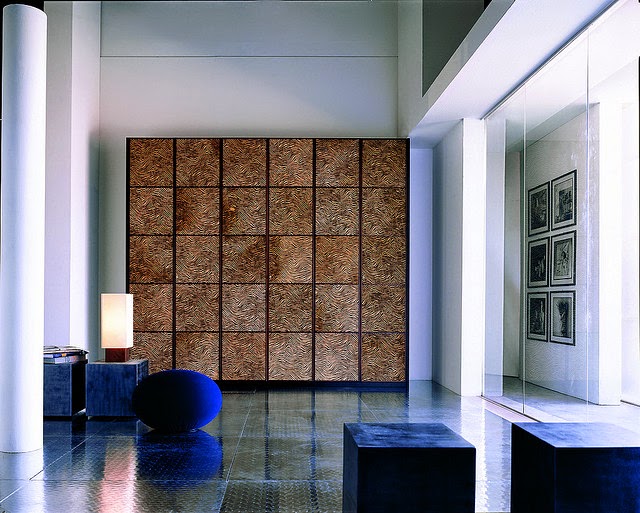Interior Design Junkie
Friday, 19 September 2014
Wednesday, 27 February 2013
History of the interior
In the past, Interiors were put together instinctively as a
part of the process of building. The profession of interior design has been a
consequence of the development of society and the complex architecture that has
resulted from the development of industrial processes. The pursuit of effective
use of space, user well-being and functional design has contributed to the
development of the contemporary interior design profession.
In ancient India, architects used to work as interior
designers. This can be seen from the references of Vishwakarma the architect -
one of the Gods in Indian mythology. Additionally, the sculptures depecting
ancient texts, events are seen in palaces built in 17th century India.
The Dark Ages led to a time of wood paneling, minimal
furniture, and stone-slab floors. During the time people added deccorative
elements by putting wall fabrics and stone carvings. Coming out of the Dark
Ages the work of color and ornamentation was introduced. And in the 12th
century the Gothic Style came out and is noted for opened interiors and natural
light.
Throughout the 18th century and into the early 19th Century,
interior decoration was the concern of the homemaker or, in well off families
an upholsterer or craftsman may influence the style of the interior space.
Architects would also employ craftsmen or artisans to complete interior design
for their buildings. Towards the end of the 19th century interior decorating
emerged as a profession in the Western world. This was due to various actions,
particularly by women, to professionalise the homemaking process. Elsie De
Wolfe has been credited with the creation of the interior decorating
profession. Having successfully re-designed her own home, De Wolfe began
offering her services to other people within her social circle. As people began
offering interior decoration as a service the professionalization of this
service gained momentum.
This movement towards professionalization was reinforced by
the publication of books on the subject. Publications include the book
Suggestions for House Decoration in Painting, Woodwork and Furniture (1876) by
Anges and Rhoda Garrett, Elsie De Wolfe’s The House in Good Taste (1913) and
articles by Candace Wheeler such as Principles of Home Decoration with
Practical Examples (1903). Most of the books were published by women and
clearly suggested the profession was within the women’s domain, E.g. The
two-part article Interior Decoration as a Profession for Women (1895), written
by Candace Wheeler.
As previously mentioned, before formal interior decorators
evolved the job was the concern of craftsmen or upholsterers. This means that
many ‘decorators’ at this time were dealers in the elements needed for
interiors. This called into question the qualifications of the decorator and
their standing as an independent advisor. This gave term interior decorator
negative connotations for some, as a painter or curtain sales person can be a
self-appointed decorator. Hence, the decorators favoured term Interior
Designer. Interior design has now developed past the point of decoration and
the terms, although overlapping, are distinct.
The most prominent development of the interior design
profession was after World War II. From the 1950s onwards spending on the home
increased. Interior design courses were established, requiring the publication
of textbooks and reference sources. Historical accounts of interior designers
and firms distinct from the decorative arts specialists were made available.
While organisations to regulate education, qualifications, standards and
practices, etc. were established for the profession.
Interior design was previously seen as playing a secondary
role to architecture. It also has many connections to other design disciplines,
involving the work of architects, industrial designers, engineers, builders,
craftsmen, etc. For these reasons the government of interior design standards
and qualifications was often incorporated into other professional organisations
that involved design. Organisations such as the Chartered Society of Designers,
established in the UK in 1986, and the American Designers Institute, founded in
1938, were established as organisations that governed various areas of design.
It was not until later that specific representation for the interior design
profession was developed. The US National Society of Interior Designers was
established in 1957, while in the UK the Interior Decorators and Designers
Association was established in 1966. Across Europe, other organisations such as
The Finnish Association of Interior Architects (1949) were being established
and in 1994 the International Interior Design Association was founded.
Ellen Mazur Thomson, author of Origins of Graphic Design in
America (1997), determined that professional status is achieved through
education, self-imposed standards and professional gate-keeping organisations.
Having achieved this, interior design became an accepted profession.
Monday, 23 July 2012
Interior design
Interior design describes a group of various yet related projects that involve turning an interior space into an "effective setting for the range of human activities" that are to take place there. An interior designer is someone who conducts such projects. Interior design is a multifaceted profession that includes conceptual development, liaising with the stakeholders of a project and the management and execution of the design.
Interior design as carried out in the US is an almost entirely different practice to that carried out in the UK. What follows relates mainly to the US.
Interior design as carried out in the US is an almost entirely different practice to that carried out in the UK. What follows relates mainly to the US.
Wednesday, 14 September 2011
Interior design
Interior design is a multi–faced profession in which creative and technical solutions are applied within a structure to achieve a built interior environment and home lifestyle enhancement.
The interior design process follows a systematic and coordinated methodology, including research, analysis, and integration of knowledge into the creative process, whereby the needs and resources of the client are satisfied to produce an interior space that fulfils the project goals.
Subscribe to:
Posts (Atom)





